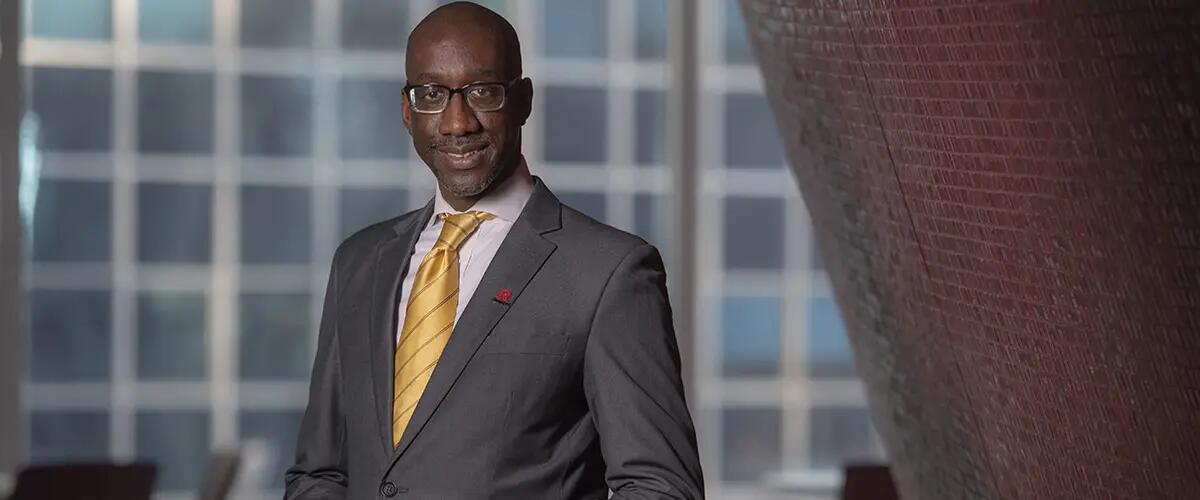
Professor Jeffrey Robinson. Photo Credit: Nick Romanenko
Working to correct inequity in innovative tech entrepreneurship
When innovation in America begins to look more diverse, Rutgers Business School professor Jeffrey Robinson will have helped to influence the change.
Robinson’s work to support entrepreneurs and urban entrepreneurship has attracted millions of dollars in federal government funding, including an estimated $3.5 million for Rutgers-based projects. His research has helped to ensure that federal funding intended to advance innovative technology in the U.S. is reaching tech entrepreneurs of color as well as female founders.
At Rutgers Business School, he helped to build The Center for Urban Entrepreneurship and Economic Development and supports programs that nurture first-generation business owners and diverse entrepreneurs. He teaches social entrepreneurship and writes about leadership.
In addition to his research, he advocates for diversity among a faculty who train and mold business leaders of the future at Rutgers and mentors student entrepreneurs and students studying entrepreneurship.
In January, his scholarly work earned him the appointment of Prudential Chair. He spoke about some of his work and its impact in a recent interview.
Tell us about your research on inclusive innovation?
We first got federal grant money from the Department of Commerce’s Minority Business Development Agency in 2016. At that time, we were working on the small business innovation research grant program and one of the things I found in my research was that participation rates of women and minorities was very low. They were not getting selected for this program, so we created an initiative to do some training and development of technology-focused companies so they could be competitive in applying for the small business innovation research grants. In 2018, we started doing a couple of local initiatives. We created a Black and Latino Technology Ventures Pre- Accelerator (BLT) through The Center for Urban Entrepreneurship and Economic Development and that addressed the need to find better representation inside technology venture accelerators. They’re all over the place in our metropolitan area, but when we looked at who was in them, it was very, very few people of color and almost no Black or Hispanic tech entrepreneurs. Our goal was to try to change those numbers. That program has been successful. We’re into our fourth cohort. Some more research grant money came from the National Science Foundation. One grant was to do research on the Innovation Corp Program. (I-Corp.) Looking at diversity issues with the program itself, which once again, is a federally funded program that was not very diverse so the questions were, what is the program and how is it functioning to include women and members of underrepresented groups, but the other part was to figure out what some of the best practices were for those sites around the country (99 sites in all) that were successful in having women and minorities involved.
What resulted from that research?
We’ve created a best practice report that spells out what’s happening (regarding diversity and inclusion) in the I-Corp network since its inception in 2012.
What do you take from your research and to apply to the Northeast Innovation Hub?
The Northeast Hub is like any other hub. We are all trying to bridge the gap between invention and commercialization. A lot of that has to do with how research and inventions that come out of universities get transferred, translated into the real world. When we think about how to remain competitive as a country, you can’t be a reasonable person and not think about how the demographics of America are changing, and those demographic changes should make you think about how to make the inventors and the innovators much more diverse than they are right now so we can continue to have the competitive edge. The Northeast Hub along, with all the other hubs, is charged with thinking about that and doing something about that. My research helps us think about how we’re doing outreach and makes us think about how we’re doing instruction. It makes us think about where we’re looking for inventions and how we’re supporting inventors and innovators who are women and people of color. That is not the only thing the hub is focused on, but that makes my research very relevant to what we do in the Northeast.
What role will you play at the Innovation Hub?
The big idea is to get deep tech ventures or STEM-related innovations that come out of universities and to ensure that deep tech innovators are as diverse as the nation. Adding diversity means there’s a lot of work being done with partners and pipeline programs, and graduate student programs. My role is to research how effective those initiatives and training are. There are still research questions out there about what the most effective ways are to do that, and what are the patterns of commercialization, what’s successful, what’s not successful. I don’t have to do this alone. We create incentives for researchers from around the region to study what’s going on in the Northeast Hub. My job is to coordinate and incentivize that research.
You’ve also been working to raise the profile of social entrepreneurship in New Jersey.
Yes, in fact, we’re going to do a New Jersey Social Entrepreneurship Summit on June 2 in Newark. For years, I’ve been involved in supporting people who want to create social ventures and hosting events and summits and training for social entrepreneurs. New Jersey has issues and challenges like any other metropolitan area. Some of them are of a social economic nature and some of them are environmental. The solutions to those problems can’t always be solved by government or a philanthropic organization or a non-profit. Social entrepreneurship is a different business model that addresses problems and uses the principles of business and the sensibilities of non-profits or philanthropic organizations. Throw in a little sustainability and a lot of chutzpah and you’ve got a group of people who can set up organizations and businesses that have this double bottom line or triple bottom line. We’ve got lots of examples that are right in and around our Rutgers communities whether that’s Newark, New Brunswick, or Camden. It’s people who are doing urban farming and people who are involved in composting and figuring how to treat the environment in a better way, and its people who are doing fantastic things in terms of youth development.
What led to your new book (with co-author Randal Pinkett), Black Faces in High Places?
This book is, in many ways, the advanced course from the first book, Black Faces in White Places, that we wrote 12 years ago. We were seeing a lot of bad signals and hearing a lot of bad stories about how Black professionals were very frustrated with what they were seeing in their organizations, corporations and even in entrepreneurship. So, one of the reasons we wrote the book was to try to write down some of the lessons that we’ve learned over the years and some of the lessons that we’ve learned from interviewing some of the most prominent Black leaders across sectors who we know or know of. That was the genesis of the book. We start off talking about the Black CEOs who reacted to the murder of George Floyd. That’s where we start because one of the questions people usually ask related to the title is, well, who are these Black faces in high places and what do they do when they get there. We have examples from across different sectors of the economy and then on top of it, we thought about what they said to us and came up with 10 strategic actions that are the things we found in common among these people. There are great examples who we talk about, whether its Don Thompson who came up through the ranks of McDonald’s and ended up becoming the CEO, or Geoffrey Canada who created the Harlem Children’s Zone, a $70 million non-profit organization transforming the lives of young people. We have examples like Ursula Burns and Carla Harris, one from Xerox and the other from Morgan Stanley, who talk about their stories of navigating those corporations.
- Susan Todd
Press: For all media inquiries see our Media Kit


